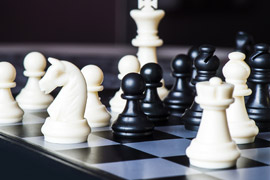May 25th, 2016
The Book and The Novelty
Harrison Reed, PA-C
Friedel rocked the chess world when he created Chessbase, a computerized database that catalogued every single game of chess ever played. This stockpile of chess history not only recorded the individual moves of every match, it revealed an embarrassing truth: even the grandmasters rely on heavy repetition.
In chess, there are a finite number of opening moves. No matter which one a player selects, it has been played millions of times in prior games. The second move, no matter what, will also look familiar from some fraction of those previous games. The same holds true for the third and the fourth and the fifth, each to a smaller degree. While the number of prior identical games will decrease with each subsequent turn, the fact remains that someone, somewhere, has played the exact combination of moves before. The best players in the world can exchange pieces for hours without ever featuring an original combination of moves.
 The massive collection of known chess board positions is known as “The Book.” Many moves in The Book are so well known in chess circles that grandmasters can play portions of a game from strict memory, without any original thought or tactic. With such well-documented and rehearsed strategy, you might wonder why chess fanatics even bother with the game at all.
The massive collection of known chess board positions is known as “The Book.” Many moves in The Book are so well known in chess circles that grandmasters can play portions of a game from strict memory, without any original thought or tactic. With such well-documented and rehearsed strategy, you might wonder why chess fanatics even bother with the game at all.
But there is a special moment that happens in nearly every chess match. As two players locked in battle lunge and parry, feign and circle, they stray further and further from the routine and predictable setups. And then, in a single move, the players find themselves in a situation that is utterly unique, never before concocted in a prior match. From that point on, the players have no road map, no blueprint. The game is pure creation.
That moment is known as The Novelty. And it is the reason people play the game.
Of course, medicine has a Book, too. Heck, medicine has a whole library of Books. The amount of established medical knowledge now doubles at an alarming rate. And with each large clinical trial or new set of recommendations from expert organizations, the known moves in medicine become a little more established. Sometimes it seems even the grandmasters of medicine can just play from memory.
But medicine has a complexity that chess never will. We don’t play on a fixed wooden board with the same set of pieces. We practice at the intersection of a unique patient and a dynamic world. It is great to know the Book, but it is even better to know when to make a different move, when the rules do not apply, when to break convention.
Today’s version of medicine may feel like speed chess, with pieces slammed down with as much regard to the time on the clock as the position on the board. But every patient’s story has a little wrinkle that makes it different. That requires us to always be prepared to make a move for the sole benefit of that individual. That is The Novelty.
And it is the reason we play the game.

; [/php]/images/AU000_hreed.jpg)

See this related title:
“n=1: How the Uniqueness of Each Individual Is Transforming Healthcare” Hardcover – February 3, 2015by John Koster (Author), Gary Bisbee (Author), Ram Charan (Author);
Homeopathy.
Absolutely! It’s that intersection between the science of medicine & the art of the interpersonal interaction.